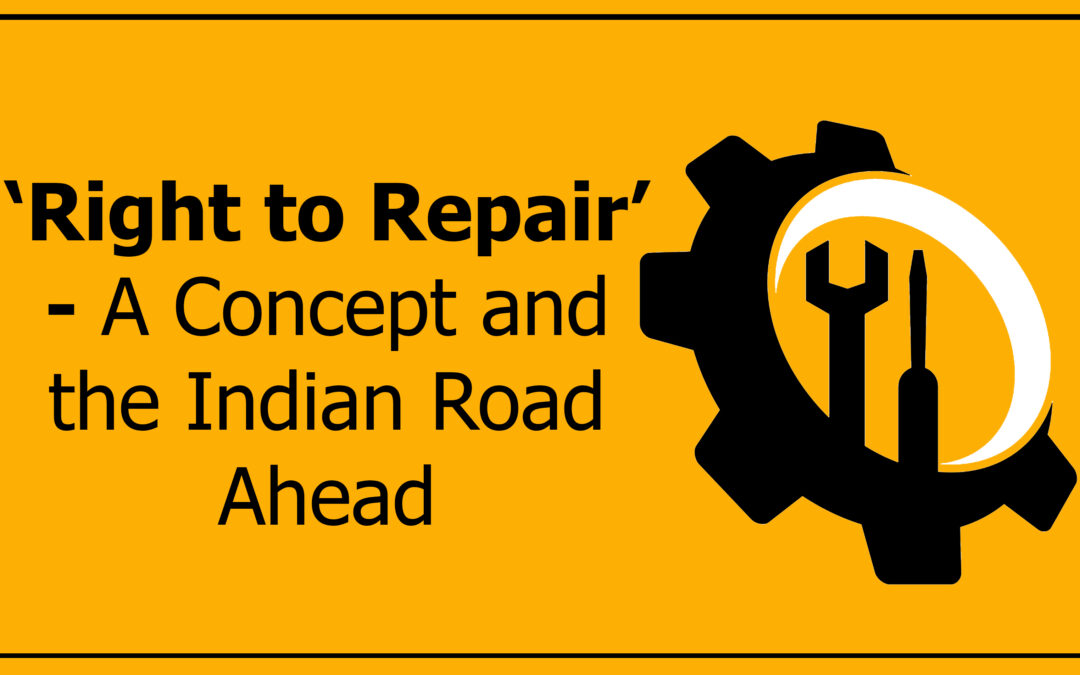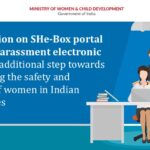The ‘Right to Repair’ has been a long-standing debate which the manufacturers have been fervently resisting on the pretext of protecting their Intellectual Property Rights (“IPRs”). This right basically refers to the end-consumers’ right to get the product repaired at their own convenience. Recently the debate on this issue has gained a new momentum in India because of the idea of LiFE[1] movement through sustainable consumption introduced by our Prime Minister during the UN Climate Change Conference last year. The concept of ‘Right to Repair’, being crucial for sustainable consumption, is naturally drawing the attention in the context of sustainability.
‘Right to Repair’ can play a pivotal role in increasing sustainability
A product that cannot be repaired or is designed with an artificially limited life[2] ultimately gets added to already unmanageable volumes of e-waste. On the other hand, the countries across the globe are recognizing the need for life cycle management of electronic products and the need to ensure sound end-of-life management to get rid of the ever-increasing e-wastes. Simultaneously, it is acknowledged that making products durable and easy to repair will empower consumers in contributing to a circular economy. But, as we know, the companies avoid publication of manuals and often plan obsolescence of goods so that the consumers are forced to buy the latest products. The manufacturer’s monopoly on repair processes makes the customer’s “right to choose” limited as well.
However, until recently, the debate on ‘right to repair’ used to revolve around the conflict between the manufacturer’s right and the consumer’s right where the former would prevail. But now the addition of environmental aspect to this conflict has tilted the balance in favour of the consumers’ right.
In a bid to emphasize the ‘LiFE’ movement in India, the Department of Consumer Affairs has started developing a framework for ‘Right to Repair’ which is supposed to bring a notable change with respect to
-
sustainability of the products and
-
employment generation by allowing third-party repairs.
Present Positions of Law in Different Countries
Let us now have a look at the legislative and judicial progress in other countries to get an idea about various principles related to ‘Right to Repair’. In USA, the New York State Legislature last year passed the Fair Repair Act, 2021 which requires the manufacturers to make parts, tools, information, and software available to consumers and independent repair shops. However, the Act is limited to motor vehicles or motor vehicle equipment manufacturers[3].
In UK, B.L.M.C. vs Armstrong Patents Ltd is one of the earlier cases which dealt with the right to repair. This case had arisen when the copyright on exhaust pipes was infringed by a consumer in their effort to repair the car. The court noted that the company cannot use its IP right to starve the spare part market. It further noted that companies often use their monopoly rights to force the obsolescence of products, which the Court cannot encourage. The Court concluded by stating that repair is allowed, but replacing the product altogether is not.
The new Eco-design for Energy-Related Products and Energy Information Regulations, 2021 enforced by the UK Government provides a list of requirements from the manufacturers to make the right of repair accessible to the consumers. Some of the requirements are as follows:
-
All the spare parts listed must be made available to professional repair people for 10 years.
-
Access to repair and maintenance information must also be provided.
-
Product designs must be made uniform and conformity checks must be undertaken to that effect.
France has implemented the concept of ‘Repairability Index’ to encourage consumers to choose more repairable products, and manufacturers to improve the repairability of their products. The index requires the manufacturers to display on their electronic products five parameters which would help consumers understand if the products are: ‘Repairable’, ‘Difficult to repair’, or ‘Not repairable at all’.
In Australia, there is no specific law to enforce ‘Right to Repair’, but the concept exists there in the context of Motor Vehicles which is similar to the position of US on this issue. In the landmark case of Calidad vs Seiko (2020), the High Court of Australia clearly defined what constitutes repair of a patented product. In this case, cartridges that were originally for single use were converted to make them suitable for multiple uses. These multi-use cartridges were then imported into Australia by Calidad when the case arose. The Court noted that under patent law, two doctrines exist – the doctrine of exhaustion and the doctrine of implied license. The doctrine of exhaustion states that the patentee’s right on the product is exhausted on first sale, whereas the implied license doctrine envisions that each product being sold is on license and therefore any restrictions that the manufacturer sets on the product will apply, no matter the number of times the product is sold. The Court, however, concluded that the doctrine of exhaustion would apply in this case. The Court further stated that while a consumer has the right to repair regardless of the IP rights that a manufacturer might hold over a product, he cannot modify the product itself.
India to formally recognise the ‘Right to Repair’ as a consumer right
As already mentioned, India has started the process of making legislation on ‘right to repair’. The Committee set up by the Department of Consumer Affairs has identified the following sectors for implementation of the ‘right to repair’:
-
Farming Equipment,
-
Mobile Phones/ Tablets,
-
Consumer Durables and
-
Automobiles/Automobile Equipment
In the context of sustainability, since the extension of the product life is equally important in addition to reuse and recycling, the regulators are putting more pressure to look at product life extension through customer-enabled repair. It will have a positive effect on logistics and will resultantly reduce the carbon footprint. For example, the Securities and Exchange Board of India (SEBI) has come up with the Business Responsibility and Sustainability Report (“BRSR”) which can be interlinked with the ‘Right to Repair’ when we move closer to the new era of sustainability. Principle 2 of BRSR prescribes that businesses should provide goods and services in a manner that is sustainable and safe. One of the essential indicators under this principle describes the processes in place to safely reclaim products for reusing, recycling, and disposing of at the end of life. The leadership indicator under this principle puts up questions regarding whether the entity conducted Life Cycle Assessments for any of its products. Principle 6 of BRSR prescribes that businesses should make efforts to protect and restore the environment. It requires disclosures regarding the category of waste generated and total waste recovered through recycling, re-using, or other recovery operations.
The main challenge for implementation of this right is the objections from the manufacturers that exposing the intellectual property to third-party or amateur repair services or repairers could lead to exploitation and impact the security of devices. The present position of law in our country is also not entirely in favour of this right. Section 52 of the Copyright Act, 1957 permits the right to change software for non-commercial purposes but does not mention repair issues. Also, the independent repairers cannot be considered a non-commercial representation since they provide repair services for profit. This right is also limited by provisions of digital rights management (“DRM”) under India’s Copyright Act, which allows software manufacturers to exert excessive control over how technology is used and therefore, signifies that repair work related to software is considered illegal.
It is pertinent to mention here that, though India had no specific law on this subject so far, the courts, in some cases, already discussed the scope of this right within the existing legal framework. In the case of Shamsher Kataria v Honda Siel Cars India Ltd (2014), the Competition Commission of India (“CCI”) held 14 automobile manufacturing companies liable for engaging in anti- competitive practices and abusing their dominant position, by selling spare parts only to authorized dealers and not in the open market. The CCI highlighted that the ‘right to repair’ can be implicitly observed in the definition of “Consumer rights” defined under section 2(9) of the Consumer Protection Act, 2019 of the Consumer Protection Act, 2019. CCI showed that the Original Equipment Manufacturers (“OEMs”) who were the car manufacturers, monopolized the secondary spare-parts market also. This restricted the independent repairers and other non-authorized repairers from accessing the secondary market.
Further, in Sanjeev Nirwani v HCL (2015), the District Consumer Disputes Redressal Forum (East), NCT OF Delhi, observed that ‘services’ include paid post-warranty period services, and thus, an OEM is mandated to provide spare parts and consumable items like batteries for the operation of the laptops. The forum concluded by stating that activities such as this restrict or impede the right to repair of a customer and must be classified as a “restrictive trade practice” under the Consumer Protection Act.
Now, let us watch how far the provisions and principles discussed above influence the final structure of our “Right to Repair” law. Lexplosion, however, will keep a close watch on any new development in this field and continue to give updates on the same.
References:
-
‘Right to Repair’, European Parliament Briefing, https://www.europarl.europa.eu/RegData/etudes/BRIE/2022/698869/EPRS_BRI(2022)698869_EN.pdf
-
‘The French repairability index, A first assessment – one year after its implementation’, https://www.halteobsolescence.org/, https://www.halteobsolescence.org/wp-content/uploads/2022/02/Rapport-indice-de-reparabilite.pdf
-
The 192nd General Court of the Commonwealth of Massachusetts, https://malegislature.gov/Laws/SessionLaws/Acts/2012/Chapter368
-
‘Right to Repair’ Press Release, https://pib.gov.in/PressReleasePage.aspx?PRID=1841403
-
UK Parliaments research briefing, https://researchbriefings.files.parliament.uk/documents/CBP-9302/CBP-9302.pdf
Definitions:
[1] It means “Lifestyle for the Environment”
[2] “Planned obsolescence” in other words
[3] Section 4(4) of Fair Repair Act, 2021
Written by: Susmit Kundu, Vidya Mukherjee
Co Authored by: Amiya Mukherjee
Disclaimer
All material included in this blog is for informational purposes only and does not purport to be or constitute legal or other advice. This blog should not be used as a substitute for specific legal advice. Professional legal advice should be obtained before taking or refraining from an action as a result of the contents of this blog. We exclude any liability (including without limitation that for negligence or for any damages of any kind) for the content of this blog. The views and opinions expressed in this blog are those of the author/(s) alone and do not necessarily reflect the official position of Lexplosion Solutions. We make no representations, warranties or undertakings about any of the information, content or materials provided in this blog (including, without limitation, any as to quality, accuracy, completeness or reliability). All the contents of this blog, including the design, text, graphics, their selection and arrangement are the intellectual property of Lexplosion Solutions Private Limited and/or its licensors.
ALL RIGHTS RESERVED, and all moral rights are asserted and reserved.





